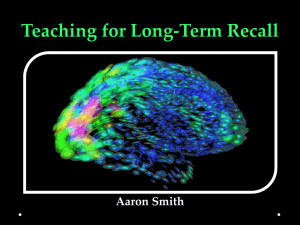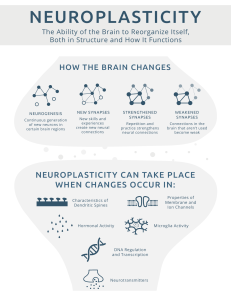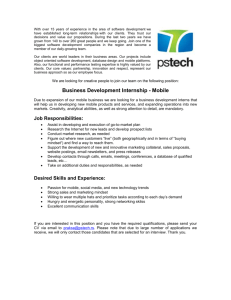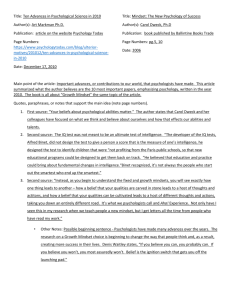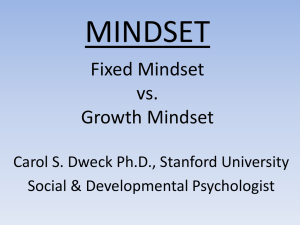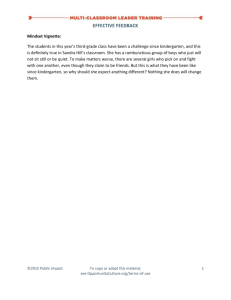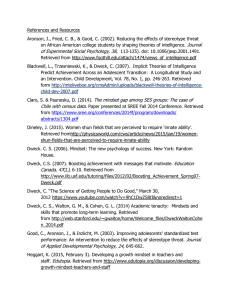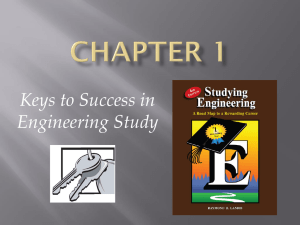Neuroplasticity - MISD GT Resources & Professional Development
advertisement
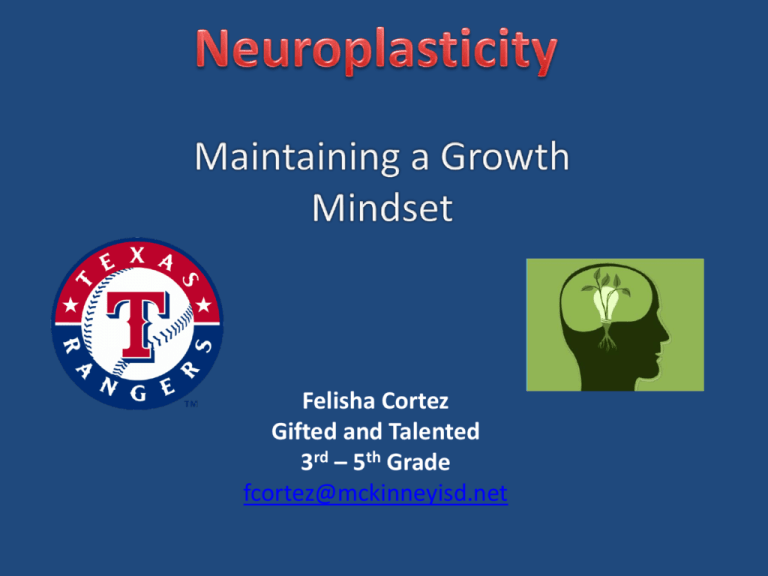
Felisha Cortez Gifted and Talented 3rd – 5th Grade fcortez@mckinneyisd.net Agenda: 1) Discussion on Intelligence 2) Malleability and Neuroplasticity of the brain 3) Strategies and activities for maintaining a growth mindset and building neuroplasticity • Article from: http://steve-wheeler.blogspot.co.uk/2015/06/unfix-yourmind.html?m=1 Intelligence After you complete this on your own discuss with your table then we will share out. Think to yourself whether or not you agree or disagree with the following statements: • Our intelligence is one of our fundamental traits. • We can all learn new things, but we cannot really change how smart we are. What is neuroplasticity? • -the ability of the brain to change, adapt, and "rewire" itself throughout our entire life. • -works both ways; it creates new connections and eliminates connections that are not used very often. Neuroplasticity in action • Example: Stroke Patients • What happens once a patient has a stroke? – Neuroplasticity begins ASAP: the brain begins the rewiring process for the patient to be able to speak and become mobile again. – The growth mindset aspect is the hard work the patients put into physical therapy to enable themselves to gain function. The brain is remarkably plastic • -Even in middle or old age it is still actively adapting to it's environment. • -All of your brains are physically growing and changing every time you learn something new and there are ways to keep that happening. • -Intelligence isn't fixed, rather it's forming and developing through our lives. • Educating students about the brain has a huge impact on their effort and motivation. • Every time you work hard and learn something new your brain grows and gets stronger. • Pre-Assessment and background knowledge on: – Brain – Fixed and Growth Mindsets • Building a Neural Network • Guess Box Activity • Concept Placemats Building a neural network I need volunteers, who wants to be a neuron? 1. Who in here has learned something new lately? 2. What is something someone has learned but is getting better at through practice? 3. What is something that someone has mastered? During the summer: • Neuroplasticity can drastically change for students. • Low SEC students tend to lose brain connections due to the fact they may not have homes filled with books or internet access/other means to advance their knowledge therefore, connections in their brain go unused. Neuroplasticity • Students need to constantly be reminded that they have the ability to get smarter and that each and every brain has an elastic quality to it. • Tell students “Once you build a strong connection, you have added density to your brain and actually made yourself smarter!” Guess Box Activity • Based on Concept Attainment Model by Jerome Bruner. • Deductive and inductive reasoning. • A box in which the contents are unknown is a good vehicle for concept attainment and critical thinking. • Can be used with any concept. Guess Box Activity Attributes of a ___________ ? Concept Placemats • Inspired by the concept formation model. • Builds a more abstract concept. • Relates to making connections, seeing relationships and defining a concept. Mindsets • A mindset is a set of personal beliefs and is a way of thinking that influences your behavior and attitude towards yourself and others. • As educators mindset directly influences how a child feels about him or herself and how he or she views him or her as a learner. Growth vs Fixed Mindset Growth: • Your brain is malleable • Talents and abilities can be developed through effort and persistence • Everyone can get smarter with work • Embrace failure • Persevere even in the face of barriers Growth vs Fixed Mindset Fixed: • Abilities and intelligence are fixed • Goal is to look smart, not dumb • Dread failure and feel it reflects upon themselves • Intelligence is static • Avoid challenges, give up easily due to obstacles Praise • The power of “not yet.” • Use words that praise students effort, process, strategies, focus and perseverance. Responding to Failure • Have students develop a failure chart. • When a student doesn’t perform as well as they hoped or they have “not yet” mastered the concept having a journal or chart may be helpful. F-irst A-ttempt I-n L-earning • Every time students push and go outside of their comfort zone new neurons form and connect. • Through continued effort and perseverance, overcoming challenges is when they become smarter. – Neurons grow Edutopia: Freedom to fail forward Resources and Ideas-included in handout • What are some possible factors that may effect student’s having a fixed mindset? • How can we as educators handle these situations when students bring them up in class? – Activity: Situational Cards References • • • • • • • Borovoy, A.E. (2015, March 13). Edutopia Five Minute Film Festival: Freedom to Fail Forward. Retrieved from from http://www.edutopia.org/blog/film-festival-learning-from-failure-resilience Dweck, C.S. (2014, January 30). A Study on Praise and Mindsets. Retrieved 2015, August 3 from https://www.youtube.com/watch?v=NWv1VdDeoRY Dweck, C.S. (2014, December 17). The Power of believing that you can improve. Retrieved 2015, August 3 from https://www.youtube.com/watch?v=_X0mgOOSpLU Joyce, W., Lasseter, J., Spencer, C. (Producers), & Anderson, S.J. (Director). (2007). Meet the Robinsons [Motion Picture]. United States: Disney Nieforth, K. (2014, May 30). Keep Moving Forward. Retrieved 2015, August 3 from https://www.youtube.com/watch?v=LmW3H-EXYS0 Ricci, M.C. (2013). Mindsets in the Classroom. Waco, TX: Prufrock Press Inc. Sentis Brain Animation Series. (2012, November 6). Neuroplasticity. Retrieved Retrieved 2015, August 3 from https://www.youtube.com/watch?v=ELpfYCZa87g
